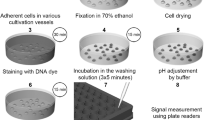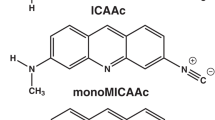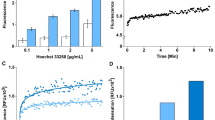Abstract
Reactive oxygen species (ROS) are continuously produced in the cell as a consequence of aerobic metabolism, and are controlled by several antioxidant mechanisms. An accurate measurement of ROS is essential to evaluate the redox status of the cell, or the effects of molecules with the pro-oxidant or antioxidant activity. Here we report a cytofluorimetric technique for measuring simultaneously, at the single-cell level, hydrogen peroxide and superoxide anion, reduced glutathione (a main intracellular antioxidant) and cell viability. The staining is performed with the fluorescent dyes 2′,7′-dichlorodihydrofluorescein diacetate (H2DCFH-DA), hydroethidine (HE), monobromobimane (MBB) and TO-PRO-3. This analysis is possible with new-generation flow cytometers equipped with several light sources (in our case, four lasers and an UV lamp), which excite different fluorochromes. This approach is extremely useful to study the balance between ROS content and antioxidants in cells receiving different stimuli, and to analyze the relationship between oxidative stress and cell death.
This is a preview of subscription content, access via your institution
Access options
Subscribe to this journal
Receive 12 print issues and online access
$259.00 per year
only $21.58 per issue
Buy this article
- Purchase on Springer Link
- Instant access to full article PDF
Prices may be subject to local taxes which are calculated during checkout




Similar content being viewed by others
References
Halliwell, B. Antioxidant defence mechanisms: from the beginning to the end (of the beginning). Free Radic. Res. 31, 261–272 (1999).
Adam-Vizi, V. & Chinopoulos, C. Bioenergetics and the formation of mitochondrial reactive oxygen species. Trends Pharmacol. Sci. 27, 639–645 (2006).
Fridovich, I. Oxygen toxicity: a radical explanation. J. Exp. Biol. 201, 1203–1209 (1998).
Halliwell, B. et al. Measuring reactive species and oxidative damage in vivo and in cell culture: how should you do it and what do the results mean? Br. J. Pharmacol. 142, 231–255 (2004).
Petersen, R.B. et al. Signal transduction cascades associated with oxidative stress in Alzheimer's disease. J. Alzheimers Dis. 11, 143–152 (2007).
Multhaup, G. et al. Reactive oxygen species and Alzheimer's disease. Biochem. Pharmacol. 54, 533–539 (1997).
Federico, A. et al. Chronic inflammation and oxidative stress in human carcinogenesis. Int. J. Cancer 121, 2381–2386 (2007).
Ozben, T. Oxidative stress and apoptosis: impact on cancer therapy. J. Pharm. Sci. 96, 2181–2196 (2007).
Shults, C.W. Antioxidants as therapy for Parkinson's disease. Antioxid. Redox Signal. 7, 694–700 (2005).
Nakabeppu, Y. et al. Oxidative damage in nucleic acids and Parkinson's disease. J. Neurosci. Res. 85, 919–934 (2007).
Buxer, S.E. et al. Analytical and numerical techniques for evaluation of free radical damage in cultured cells using imaging cytometry and fluorescent indicators. Methods Enzymol. 300, 256–275 (1999).
Drummen, G.P. et al. C11-BODIPY(581/591), an oxidation-sensitive fluorescent lipid peroxidation probe: (micro)spectroscopic characterization and validation of methodology. Free Radic. Biol. Med. 33, 473–490 (2002).
Brubacher, J.L. et al. Chemically de-acetylated 2′,7′-dichlorodihydrofluorescein diacetate as a probe of respiratory burst activity in mononuclear phagocytes. J. Immunol. Methods 251, 81–91 (2001).
Myhre, O. et al. Evaluation of the probes 2′7′-dichlorofluorescein diacetate, luminol, and lucigenin as indicators of reactive species formation. Biochem. Pharmacol. 65, 1575–1582 (2003).
Hirabayashi, Y. et al. A quantitative assay of oxidative metabolism by neutrophils in whole blood using flow cytometry. J. Immunol. Methods 82, 253–259 (1985).
Rothe, G. et al. Flow cytometric analysis of respiratory burst activity in phagocytes with hydroethidine and 2′,7′-dichlorofluorescein. J. Leukocyte Biol. 47, 440–448 (1990).
Bindokas, V.P. et al. Superoxide production in rat hippocampal neurons: selective imaging with hydroethidine. J. Neurosci. 16, 1324–1326 (1989).
Carter, W.O. et al. Intracellular hydrogen peroxide and superoxide anion detection in endothelial cells. J. Leukoc. Biol. 55, 253–258 (1994).
Pompella, A. et al. The changing faces of glutathione, a cellular protagonist. Biochem. Pharmacol. 66, 1499–1503 (2003).
Hedley, D.W. et al. Evaluation of methods for measuring cellular glutathione content using flow cytometry. Cytometry 15, 349–358 (1994).
Lee-MacAry, A.E. et al. Development of a novel flow cytometric cell-mediated cytotoxicity assay using the fluorophores PKH-26 and TO-PRO-3 iodide. J. Immunol. Methods 252, 83–92 (2001).
Schmid, I. et al. Simultaneous flow cytometric measurement of viability and lymphocyte subset proliferation. J. Immunol. Methods 247, 175–186 (2001).
Troiano, L. et al. Multiparametric analysis of cells with different mitochondrial membrane potential during apoptosis by polychromatic flow cytometry. Nat. Protoc. 2, 2719–2727 (2007).
Lugli, E. et al. Characterization of cells with different mitochondrial membrane potential during apoptosis. Cytometry A 68, 28–35 (2005).
Ferraresi, R. et al. Essential requirement of reduced glutathione (GSH) for the anti-oxidant effect of the flavonoid quercetin. Free Radic. Res. 39, 1249–1258 (2005).
Ferraresi, R. et al. Resistance of mtDNA-depleted cells to apoptosis. Cytometry A 73A, 528–537 (2008).
Misaka, K. et al. Studies on menadione reductase of bakers' yeast. II. Inhibition of the enzyme activity by NAD and stimulation of that by p-chloromercuribenzoate. J. Biochem. 58, 1–6 (1965).
Janiszewski, M. et al. Inhibition of vascular NADH/NADPH oxidase activity by thiol reagents: lack of correlation with cellular glutathione redox status. Free Radic. Biol. Med. 29, 889–899 (2000).
Cossarizza, A. & Moyle, G. Antiretroviral nucleoside and nucleotide analogues and the mitochondria. AIDS 18, 137–151 (2004).
Pinti, M. et al. Hepatoma HepG2 cells as a model for in vitro studies on mitochondrial toxicity of antiviral drugs: which correlation with the patient? J. Biol. Regul. Homeost. Agents 17, 66–71 (2003).
Shiramizu, B. et al. Placenta and cord blood mitochondrial DNA toxicity in HIV-infected women receiving nucleoside reverse transcriptase inhibitors during pregnancy. J. Acquir. Immune Defic. Syndr. 32, 370–374 (2003).
Galluzzi, L. et al. Changes in mitochondrial RNA production in cells treated with nucleoside analogues. Antivir. Ther. 10, 191–195 (2005).
Ferraresi, R. et al. Protective effect of acetyl-L-carnitine against oxidative stress induced by antiretroviral drugs. FEBS Lett. 580, 6612–6616 (2006).
Pinti, M. et al. Anti-HIV drugs and the mitochondria. Biochim. Biophys. Acta 1757, 700–707 (2006).
Rosso, R. et al. Effects of the switch from stavudine to tenovofir in HIV+ children assuming HAART: studies on mitochondrial toxicity and thymic functionality. Pediatrics Infect. Dis. J. 27, 17–21 (2008).
Acknowledgements
We acknowledge Partec GmbH (Münster, Germany) for continuous technical support. The study is partially supported by the VII Programma Nazionale AIDS, Istituto Superiore di Sanità (Rome, Italy), grant no. 30G.62 to A.C.
Author information
Authors and Affiliations
Contributions
A.C. designed the study and wrote the paper; R.F., L.B. and M.N. set up the methodologies and performed the experiments; L.T., E.R., L.G. and M.P. set up the methodologies and performed the experiments and wrote the paper.
Corresponding author
Rights and permissions
About this article
Cite this article
Cossarizza, A., Ferraresi, R., Troiano, L. et al. Simultaneous analysis of reactive oxygen species and reduced glutathione content in living cells by polychromatic flow cytometry. Nat Protoc 4, 1790–1797 (2009). https://doi.org/10.1038/nprot.2009.189
Published:
Issue Date:
DOI: https://doi.org/10.1038/nprot.2009.189
This article is cited by
-
Cytotoxicity of a new spiro-acridine derivative: modulation of cellular antioxidant state and induction of cell cycle arrest and apoptosis in HCT-116 colorectal carcinoma
Naunyn-Schmiedeberg's Archives of Pharmacology (2024)
-
Cytotoxicity of the methanol extracts and compounds of Brucea antidysenterica (Simaroubaceae) towards multifactorial drug-resistant human cancer cell lines
BMC Complementary Medicine and Therapies (2023)
-
Cytotoxicity, acute and sub-chronic toxicities of the leaves of Bauhinia thonningii (Schumach.) Milne-Redh. (Caesalpiniaceae)
BMC Complementary Medicine and Therapies (2023)
-
Antibacterial mechanism analysis and structural design of amino acid-based carbon dots
Journal of Materials Science (2023)
-
Apoptotic and antioxidant effects in HCT-116 colorectal carcinoma cells by a spiro-acridine compound, AMTAC-06
Pharmacological Reports (2022)
Comments
By submitting a comment you agree to abide by our Terms and Community Guidelines. If you find something abusive or that does not comply with our terms or guidelines please flag it as inappropriate.



